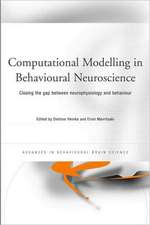Alzheimer's Disease: Methods and Protocols: Methods in Molecular Medicine, cartea 32
Editat de Nigel M. Hooperen Limba Engleză Paperback – 9 noi 2010
| Toate formatele și edițiile | Preț | Express |
|---|---|---|
| Paperback (1) | 1102.31 lei 6-8 săpt. | |
| Humana Press Inc. – 9 noi 2010 | 1102.31 lei 6-8 săpt. | |
| Hardback (1) | 730.92 lei 6-8 săpt. | |
| Humana Press Inc. – 29 dec 1999 | 730.92 lei 6-8 săpt. |
Din seria Methods in Molecular Medicine
- 5%
 Preț: 1278.74 lei
Preț: 1278.74 lei - 15%
 Preț: 655.78 lei
Preț: 655.78 lei - 5%
 Preț: 1106.50 lei
Preț: 1106.50 lei - 5%
 Preț: 727.44 lei
Preț: 727.44 lei - 5%
 Preț: 1108.72 lei
Preț: 1108.72 lei - 15%
 Preț: 650.55 lei
Preț: 650.55 lei - 5%
 Preț: 735.66 lei
Preț: 735.66 lei - 18%
 Preț: 947.35 lei
Preț: 947.35 lei - 18%
 Preț: 948.92 lei
Preț: 948.92 lei - 5%
 Preț: 1114.54 lei
Preț: 1114.54 lei - 5%
 Preț: 1114.91 lei
Preț: 1114.91 lei - 15%
 Preț: 658.55 lei
Preț: 658.55 lei - 5%
 Preț: 734.01 lei
Preț: 734.01 lei - 5%
 Preț: 1111.61 lei
Preț: 1111.61 lei - 5%
 Preț: 1104.32 lei
Preț: 1104.32 lei - 5%
 Preț: 723.21 lei
Preț: 723.21 lei - 5%
 Preț: 1106.13 lei
Preț: 1106.13 lei - 5%
 Preț: 723.05 lei
Preț: 723.05 lei - 5%
 Preț: 1108.35 lei
Preț: 1108.35 lei - 5%
 Preț: 723.42 lei
Preț: 723.42 lei - 5%
 Preț: 1115.65 lei
Preț: 1115.65 lei - 5%
 Preț: 786.86 lei
Preț: 786.86 lei - 5%
 Preț: 1133.01 lei
Preț: 1133.01 lei - 5%
 Preț: 1114.71 lei
Preț: 1114.71 lei
Preț: 1102.31 lei
Preț vechi: 1160.32 lei
-5% Nou
Puncte Express: 1653
Preț estimativ în valută:
210.92€ • 220.81$ • 174.53£
210.92€ • 220.81$ • 174.53£
Carte tipărită la comandă
Livrare economică 05-19 aprilie
Preluare comenzi: 021 569.72.76
Specificații
ISBN-13: 9781617371615
ISBN-10: 1617371610
Pagini: 408
Ilustrații: XIV, 408 p.
Dimensiuni: 152 x 229 x 24 mm
Greutate: 0.62 kg
Ediția:Softcover reprint of hardcover 1st ed. 2000
Editura: Humana Press Inc.
Colecția Humana
Seria Methods in Molecular Medicine
Locul publicării:Totowa, NJ, United States
ISBN-10: 1617371610
Pagini: 408
Ilustrații: XIV, 408 p.
Dimensiuni: 152 x 229 x 24 mm
Greutate: 0.62 kg
Ediția:Softcover reprint of hardcover 1st ed. 2000
Editura: Humana Press Inc.
Colecția Humana
Seria Methods in Molecular Medicine
Locul publicării:Totowa, NJ, United States
Public țintă
Professional/practitionerCuprins
to Alzheimer's Disease.- The Genetics of Alzheimer's Disease.- Advances in Methodology and Current Prospects for Primary Drug Therapies for Alzheimer's Disease.- Production and Functional Assays of Recombinant Secreted Amyloid Precursor Protein (APP) (sAPP?).- Quantifying A?1–40 and A?1–42 Using Sandwich-ELISA.- Electrophoretic Separation and Immunoblotting of A?1–40 and A?1–42.- A?-Induced Proinflammatory Cytokine Release from Differentiated Human THP-1 Monocytes.- Effects of the ?-Amyloid Peptide on Membrane Ion Permeability.- Analysis of ?-Amyloid Peptide Degradation In Vitro.- Posttranslational Modifications of Amyloid Precursor Protein.- Posttranslational Modifications of the Amyloid Precursor Protein.- Using an Amyloid Precursor Protein (APP) Reporter to Characterize ?-Secretase.- Inhibition of ?-Secretase by Zinc Metalloproteinase Inhibitors.- Development of Neoepitope Antibodies Against the ?-Secretase Cleavage Site in the Amyloid Precursor Protein.- ?-Secretase.- Using ?-Secretase Inhibitors to Distiguish the Generation of the A? Peptides Terminating at Val-40 and Ala-42.- Designing Animal Models of Alzheimer's Disease with Amyloid Precursor Protein (APP) Transgenes.- Phosphorylation of Amyloid Precursor Protein (APP) Family Proteins.- Determining the Transmembrane Topology of the Presenilins.- Normal Proteolytic Processing of the Presenilins.- Apoptotic Proteolytic Cleavage of the Presenilins by Caspases.- The Phosphorylation of Presenilin Proteins.- Interaction of the Presenilins with the Amyloid Precursor Protein (APP).- Distribution of Presenilins and Amyloid Precursor Protein (APP) in Detergent-Insoluble Membrane Domains.- Characterization and Use of Monoclonal Antibodies to Tau and Paired Helical Filament Tau.- Tau PhosphorylationBoth In Vitro and in Cells.- Transglutaminase-Catalyzed Formation of Alzheimer-Like Insoluble Complexes from Recombinant Tau.
Recenzii
"...this volume contains well-written chapters containing factual insights and useful clarifications. An example is David Allsop's introduction of the field through the orthodox views of the amyloid cascade hypothesis that in the exposition of others is often quite simplistic, but here is presented with complexity and wisdom deserving of serious consideration....they are provided in a format that invites the reader to undertake studies and examine the underpinnings of the subject beyond that found in the primary publications and not covered in such a practical manner in other reviews."- Journal of Molecular Neuroscience
Textul de pe ultima copertă
With the molecular mechanisms underlying the various forms of muscular dystrophy now rapidly clarifying, precise diagnosis has become a reality, and even a requirement in clinical practice. In Muscular Dystrophy: Methods and Protocols, Katherine Bushby and Louise Anderson have assembled an outstanding collection of key techniques for the analysis of DNA and protein from patients suspected to suffer from muscular dystrophy. Each method is highly detailed to ensure success and is presented by a hands-on expert who uses it on a day-to-day basis. The various DNA techniques focus on both the X-linked muscular dystrophies and the autosomal recessive muscular dystrophies. The protein methods include expression analysis, multiplex western blot analysis, immunocytochemical analysis, and reviews of immunological reagants and of amplification systems. Also discussed are the use of animal models to understand human muscular dystrophy and the available options for gene-based therapy.
Comprehensive and highly practical, Muscular Dystrophy: Methods and Protocols offers today‚s diagnostic laboratories, basic and medical researchers, and active clinicians an authoritative collection of tools that will serve as exacting diagnostic tools as well as greatly empowering research on the novel therapeutics now beginning to emerge.
Comprehensive and highly practical, Muscular Dystrophy: Methods and Protocols offers today‚s diagnostic laboratories, basic and medical researchers, and active clinicians an authoritative collection of tools that will serve as exacting diagnostic tools as well as greatly empowering research on the novel therapeutics now beginning to emerge.
















